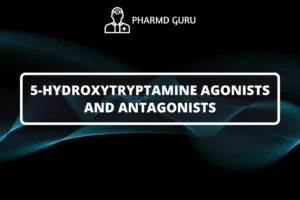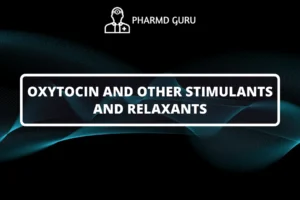HISTAMINES AND ANTIHISTAMINICS
Autocoids are endogenous substances that act locally on various tissues to regulate physiological processes. Histamines are one of the important autocoids involved in allergic and inflammatory responses. In this article, we will explore the pharmacology of histamines and antihistaminics, focusing on their mechanisms of action, therapeutic applications, and considerations for use.
SCROLL DOWN TO THE BOTTOM OF THIS PAGE FOR ACTUAL NOTES.
Histamines
Histamines are naturally occurring compounds found in various cells, including mast cells, basophils, and neurons. They play a crucial role in mediating allergic reactions, immune responses, and gastric acid secretion. Histamines exert their effects by binding to specific receptors, primarily H1 and H2 receptors.
Mechanism of Action
When released from mast cells or basophils, histamines bind to H1 receptors located on smooth muscle cells, nerve endings, and endothelial cells. This binding triggers a cascade of intracellular events, leading to vasodilation, increased vascular permeability, bronchoconstriction, and smooth muscle contraction. Histamines also bind to H2 receptors present on gastric parietal cells, stimulating the secretion of gastric acid.
Therapeutic Applications
- Allergic Conditions: Histamines are involved in the pathogenesis of allergic reactions, such as hay fever, allergic rhinitis, and urticaria. Antihistamines, which we will discuss next, are commonly used to alleviate the symptoms associated with these conditions, including itching, sneezing, and nasal congestion.
- Gastric Acid-related Disorders: The activation of H2 receptors by histamines stimulates gastric acid secretion. Therefore, H2 receptor antagonists, also known as H2 blockers, are used in the treatment of gastric ulcers, gastroesophageal reflux disease (GERD), and other acid-related disorders.
Antihistamines
Antihistamines, also referred to as histamine receptor antagonists, are medications that block the effects of histamines by competitively binding to H1 receptors. They are widely used to alleviate the symptoms of allergic conditions and reduce histamine-mediated responses.
Mechanism of Action
Antihistamines work by occupying H1 receptors and preventing histamines from binding to these receptors. By doing so, they inhibit or reduce the histamine-induced effects, including vasodilation, increased vascular permeability, bronchoconstriction, and itching. Antihistamines do not block H2 receptors responsible for gastric acid secretion.
Therapeutic Applications
- Allergic Rhinitis: Antihistamines are commonly used to relieve symptoms of allergic rhinitis, including sneezing, itching, nasal congestion, and runny nose. They can be taken orally or used as nasal sprays, depending on the formulation.
- Urticaria: Antihistamines are effective in managing the symptoms of urticaria, commonly known as hives. They help reduce itching, redness, and swelling associated with this condition.
- Allergic Conjunctivitis: Antihistamine eye drops are available to alleviate symptoms of allergic conjunctivitis, such as redness, itching, and excessive tearing.
- Motion Sickness: Some antihistamines have sedative properties, making them useful in preventing and treating motion sickness by reducing dizziness, nausea, and vomiting.
Considerations for Use
When using antihistamines, several considerations should be kept in mind:
- Sedative Effects: Some antihistamines have sedative properties and can cause drowsiness. It is important to be cautious when operating machinery or driving a vehicle while taking these medications.
- Drug Interactions: Antihistamines may interact with other medications, such as sedatives, tranquilizers, and certain antidepressants. It is advisable to consult a healthcare professional or pharmacist before combining medications.
- Age-specific Doses: The dosing of antihistamines may vary depending on age. Children and elderly individuals may require adjusted doses, and it is essential to follow the recommended guidelines.
- Side Effects: Common side effects of antihistamines include dry mouth, blurred vision, dizziness, and gastrointestinal disturbances. If any concerning side effects occur, it is recommended to seek medical advice.
ACTUAL NOTES:




